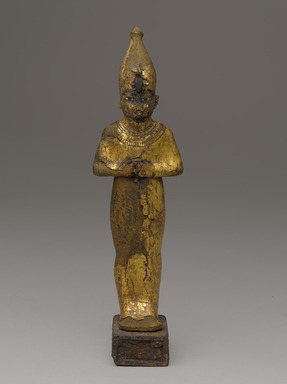
Medium: Wood, calcium ground, gold alloy leaf, copper alloy, polychromy
Geograhical Locations:
Dates:4th century B.C.E. or later
Dimensions: 8 15/16 x 2 1/2 x 1 7/8 in. (22.7 x 6.4 x 4.7 cm)
Collections:
Exhibitions:
Accession Number: 37.1375Ea-b
Image: 37.1375Ea-b_PS9.jpg,
Catalogue Description: Standing mummiform figure of the God Osiris. Wood covered with gold leaf and having some bronze accessories. The god wore the white crown flanked by feathers; the arms are indicated through the mummy wrapping and the hands exposed, knuckles meeting and each originally holding an attribute. The figure is provided with a collar which meets behind, consists of two rows of vertically radiating beads, the lower ones are drop pendants. It is not apparent whether the vertical strips behind are a part of the collar or belong to the crown. They appear to hang from the crown. Technic: The entire figure with white crown and a dowel on the under surface of the feet were carved out of a single block of wood. It is inserted in a small rectangular base with paneled sides which is of another single piece of wood. Near the four corners round holes were drilled from the bottom, reaching to within about 6 mm of the upper surface. Two of these holes were drilled too close to the sides and have broken through the panels. In the two front holes two of the round pegs remain which served to fasten the small base to its pedestal. The whole block was cut through to the bottom to receive the dowel in the feet of the figure and this shows below. The accessories separately added include 1) bronze uraeus on the front of the crown; 2) the feathers of the crown for which two dowel holes are visible on backside of each crown, 3) the eyes probably of glass or paste, 4) the beard and its straps (material not evident), 5) the attributes in the hands. The latter are closed and round holes are drilled for the reception of the fly-flap and scepter. The entire figure in each case received a layer of stucco on which gold leaf was laid. The details of the collar and ends behind modeled. The details of the collar were not carved in the wood but modeled in the plaster before the god leaf was applied. Condition: The surface is considerably darkened (by resin?) thus the material of the eyes, and other accessories is difficult to determine. Some gold leaf and stucco has dropped off. The figure has lost feathers from the headdress, the beard and part of the inlay representing beard straps, both attributes, and its pedestal. This objecy has a worm-hole in the exposed wood of the right shoulder and the nose of is hopelessly flattened.The uraeus of 342 proves to be delicately engraved. The beard-straps were not metal but paste. The right eye looks like ivory to which the pupil was added in black paste (to a flattened, perhaps somewhat roughened surface); the left eye, however, is of glass. The cornea is whiter and the pupil blacker. Presumably the original left eye was lost that this is a repair.